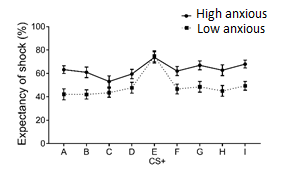Avoidance of learnt fear
Not only fear is acquired to stimulus that signals a threat, but also to stimulus that predicts this warning signal.
Avoidance to stimulus that prevents the warning signal (and the threat altogether) is referred to as “avoidance of learnt fear”.
Avoidance of learnt fear is prevalent in clinical anxiety, and provides a potential explanation for why a broad range of stimuli or situations are avoided in anxiety-related disorders (besides fear generalization).

Related work:
Wong, A. H. K., Wirth, F. M., & Pittig, A. (2022). Avoidance of learnt fear: Models, potential mechanisms, and future directions. Behaviour Research and Therapy, 151, 104056. https://doi.org/10.1016/j.brat.2022.104056
Wong, A. H. K., & Pittig, A. (2022). Avoiding a feared stimulus: Modelling costly avoidance of learnt fear in a sensory preconditioning paradigm. Biological Psychology, 168, 108429. https://doi.org/10.1016/j.biopsycho.2021.108249
Wong, A. H. K., & Pittig, A. (2020). Costly avoidance triggered by categorical fear generalization. Behaviour Research and Therapy, 129, 103606. https://doi.org/10.1016/j.brat.2020.103606
Maladaptive safety behavior
Safety behavior is an adaptive response that prevents threat when confronting a feared stimulus/situation. It becomes pathological when its cost significantly outweighs its benefit, and when it persists in the absence of realistic threat.
Besides studying the pathological features of safety behavior in clinical anxiety, I am also keen to develop measures that more closely resemble maldaptive safety behavior. For instance, introducing a reward that competes with safety behavior that parallels with costly safety behavior, and developing a dimensional measure of avoidance that resembles partial engagement in safety behavior.

Related work:
Wong, A. H. K., & Pittig, A. (2022). Threat belief determines the degree of costly safety behavior: Assessing rule-based generalization of safety behavior with a dimensional measure of avoidance. Behaviour Research and Therapy, 156, 104158. https://doi.org/10.1016/j.brat.2022.104158
Wong, A. H. K., & Pittig, A. (2021). A dimensional measure of safety behavior: A non-dichotomous assessment of costly avoidance in human fear conditioning. Psychological Research. https://doi.org/10.1007/s00426-021-01490-w
Pittig, A., Wong, A. H. K., Glück, V. M., & Boschet, J. M. (2020). Avoidance and its bi-directional relationship with conditioned fear: Mechanisms, moderators, and clinical implications. Behaviour Research and Therapy, 126, 103550. https://doi.org/10.1016/j.brat.2020.103550
Improving generalization of inhibitory learning
Extinction refers to the repeated presentations of a feared stimulus in the absence of threat, leading to an update in threat belief. In the laboratory, extinction learning is modelled by presenting the original stimulus of acquisition alone. In real life, the exact same stimulus of acquisition is, however, highly unlikely to be reproduced. In fact, generalization stimuli (GSs) that resemble the stimulus of acquisition are presented in exposure-based therapy. This line of research examines how safety learning to a GS can effectively generalize to other feared stimuli. Findings may help translating into strategies to improve treatment outcome of exposure-based therapy.
Related work:
Wong, A. H. K., Lee, J. C., Engelke, P., & Pittig, A. (2023). Reduction of costly safety behaviors after extinction with a generalization stimulus is determined by individual differences in generalization rules. Behaviour Research and Therapy, 160, 104233. https://doi.org/10.1016/j.brat.2022.104233
Wong, A. H. K., Glück, V. M., Boschet, J. M., & Engelke, P. (2020). Generalization of extinction with a generalization stimulus is determined by learnt threat beliefs. Behaviour Research and Therapy, 125, 103755. https://doi.org/10.1016/j.brat.2020.103755
Wong, A. H. K., & Lovibond, P. F. (2020). Generalization of extinction of a generalization stimulus in fear learning. Behaviour Research and Therapy, 125, 103535. https://doi.org/10.1016/j.brat.2019.103535
Individual differences in fear generalization
Related work:
Wong, A. H. K., & Beckers, T. (2021). Trait anxiety is associated with reduced typicality asymmetry in fear generalization. Behaviour Research and Therapy, 138, 103802. https://doi.org/10.1016/j.brat.2021.103802
Wong, A. H. K., & Lovibond, P. F. (2020). Breakfast or bakery? The role of categorical ambiguity in over-generalization of learned fear in trait anxiety. Emotion. Advance online publication. https://doi.org/10.1037/emo0000739
Wong, A. H. K., & Lovibond, P. F. (2018). Excessive generalisation of conditioned fear in trait anxious individuals under ambiguity. Behaviour Research and Therapy, 107, 53-63. https://doi.org/10.1016/j.brat.2018.05.012